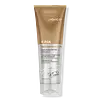What's inside
What's inside
 Key Ingredients
Key Ingredients

 Benefits
Benefits

 Concerns
Concerns

 Ingredients Side-by-side
Ingredients Side-by-side

Water
Skin ConditioningStearamidopropyl Dimethylamine
EmulsifyingParaffinum Liquidum
EmollientGlycol Stearate
EmollientPEG-8 Distearate
EmulsifyingSodium Chloride
MaskingCeteth-2
EmulsifyingHydrolyzed Keratin
HumectantLaurdimonium Hydroxypropyl Hydrolyzed Keratin
Skin ConditioningMyristyl Myristate
EmollientCitric Acid
BufferingParfum
MaskingSorbic Acid
PreservativeCetyl Alcohol
EmollientStearyl Alcohol
EmollientCarthamus Tinctorius Seed Oil
MaskingYeast Extract
Skin ConditioningAloe Barbadensis Leaf Juice
Skin ConditioningKeratin Amino Acids
Skin ConditioningMethylparaben
PreservativePropylparaben
PreservativeWater, Stearamidopropyl Dimethylamine, Paraffinum Liquidum, Glycol Stearate, PEG-8 Distearate, Sodium Chloride, Ceteth-2, Hydrolyzed Keratin, Laurdimonium Hydroxypropyl Hydrolyzed Keratin, Myristyl Myristate, Citric Acid, Parfum, Sorbic Acid, Cetyl Alcohol, Stearyl Alcohol, Carthamus Tinctorius Seed Oil, Yeast Extract, Aloe Barbadensis Leaf Juice, Keratin Amino Acids, Methylparaben, Propylparaben
Water
Skin ConditioningCetearyl Alcohol
EmollientBehentrimonium Chloride
PreservativeGlycerin
HumectantAmodimethicone
Cyclopentasiloxane
EmollientCitric Acid
BufferingIsopropyl Alcohol
SolventCetrimonium Chloride
AntimicrobialSodium Benzoate
MaskingDimethicone
EmollientTrideceth-12
EmulsifyingPanthenol
Skin ConditioningParfum
MaskingTocopheryl Acetate
AntioxidantCaramel
Cosmetic ColorantButylene Glycol
HumectantCornus Officinalis Fruit Extract
Skin ConditioningRehmannia Glutinosa Root Extract
Skin ConditioningDioscorea Japonica Root Extract
Skin ConditioningAlisma Orientale Tuber Extract
Skin ConditioningPaeonia Suffruticosa Root Extract
Skin ProtectingPoria Cocos Sclerotium Extract
AstringentCeramide NP
Skin ConditioningAlcohol
AntimicrobialHydrolyzed Silk
HumectantHydrolyzed Collagen
EmollientGelatin
Hydrolyzed Keratin
HumectantAvena Sativa Kernel Extract
Abrasive1,2-Hexanediol
Skin ConditioningHydrolyzed Wheat Protein
Skin ConditioningHydrolyzed Corn Protein
Skin ConditioningHydrolyzed Soy Protein
HumectantPhenoxyethanol
PreservativeDaucus Carota Sativa Root Extract
Skin ConditioningBrassica Oleracea Italica Extract
AstringentApium Graveolens Extract
Skin ConditioningSodium Dehydroacetate
PreservativeBrassica Oleracea Capitata Juice
Skin ConditioningOryza Sativa Extract
AbsorbentBrassica Rapa Leaf Extract
Skin ConditioningEthylhexylglycerin
Skin ConditioningSolanum Lycopersicum Fruit
EmollientIllicium Verum Fruit Extract
PerfumingCaprylyl Glycol
EmollientWater, Cetearyl Alcohol, Behentrimonium Chloride, Glycerin, Amodimethicone, Cyclopentasiloxane, Citric Acid, Isopropyl Alcohol, Cetrimonium Chloride, Sodium Benzoate, Dimethicone, Trideceth-12, Panthenol, Parfum, Tocopheryl Acetate, Caramel, Butylene Glycol, Cornus Officinalis Fruit Extract, Rehmannia Glutinosa Root Extract, Dioscorea Japonica Root Extract, Alisma Orientale Tuber Extract, Paeonia Suffruticosa Root Extract, Poria Cocos Sclerotium Extract, Ceramide NP, Alcohol, Hydrolyzed Silk, Hydrolyzed Collagen, Gelatin, Hydrolyzed Keratin, Avena Sativa Kernel Extract, 1,2-Hexanediol, Hydrolyzed Wheat Protein, Hydrolyzed Corn Protein, Hydrolyzed Soy Protein, Phenoxyethanol, Daucus Carota Sativa Root Extract, Brassica Oleracea Italica Extract, Apium Graveolens Extract, Sodium Dehydroacetate, Brassica Oleracea Capitata Juice, Oryza Sativa Extract, Brassica Rapa Leaf Extract, Ethylhexylglycerin, Solanum Lycopersicum Fruit, Illicium Verum Fruit Extract, Caprylyl Glycol
 Reviews
Reviews

Ingredients Explained
These ingredients are found in both products.
Ingredients higher up in an ingredient list are typically present in a larger amount.
Citric Acid is an alpha hydroxy acid (AHA) naturally found in citrus fruits like oranges, lemons, and limes.
Like other AHAs, citric acid can exfoliate skin by breaking down the bonds that hold dead skin cells together. This helps reveal smoother and brighter skin underneath.
However, this exfoliating effect only happens at high concentrations (20%) which can be hard to find in cosmetic products.
Due to this, citric acid is usually included in small amounts as a pH adjuster. This helps keep products slightly more acidic and compatible with skin's natural pH.
In skincare formulas, citric acid can:
While it can provide some skin benefits, research shows lactic acid and glycolic acid are generally more effective and less irritating exfoliants.
Most citric acid used in skincare today is made by fermenting sugars (usually from molasses). This synthetic version is identical to the natural citrus form but easier to stabilize and use in formulations.
Read more about some other popular AHA's here:
Learn more about Citric AcidHydrolyzed Keratin is derived from keratin. Keratin is a large protein that is naturally found in our hair and skin.
Studies show keratin is able to seal broken hair cuticles, helping to prevent split ends and breakage.
As a humectant, hydrolyzed keratin helps draw moisture from the air to your hair and skin. This helps keep your skin and hair hydrated.
Learn more about Hydrolyzed KeratinParfum is a catch-all term for an ingredient or more that is used to give a scent to products.
Also called "fragrance", this ingredient can be a blend of hundreds of chemicals or plant oils. This means every product with "fragrance" or "parfum" in the ingredients list is a different mixture.
For instance, Habanolide is a proprietary trade name for a specific aroma chemical. When used as a fragrance ingredient in cosmetics, most aroma chemicals fall under the broad labeling category of “FRAGRANCE” or “PARFUM” according to EU and US regulations.
The term 'parfum' or 'fragrance' is not regulated in many countries. In many cases, it is up to the brand to define this term.
For instance, many brands choose to label themselves as "fragrance-free" because they are not using synthetic fragrances. However, their products may still contain ingredients such as essential oils that are considered a fragrance by INCI standards.
One example is Calendula flower extract. Calendula is an essential oil that still imparts a scent or 'fragrance'.
Depending on the blend, the ingredients in the mixture can cause allergies and sensitivities on the skin. Some ingredients that are known EU allergens include linalool and citronellol.
Parfum can also be used to mask or cover an unpleasant scent.
The bottom line is: not all fragrances/parfum/ingredients are created equally. If you are worried about fragrances, we recommend taking a closer look at an ingredient. And of course, we always recommend speaking with a professional.
Learn more about ParfumWater. It's the most common cosmetic ingredient of all. You'll usually see it at the top of ingredient lists, meaning that it makes up the largest part of the product.
So why is it so popular? Water most often acts as a solvent - this means that it helps dissolve other ingredients into the formulation.
You'll also recognize water as that liquid we all need to stay alive. If you see this, drink a glass of water. Stay hydrated!
Learn more about Water